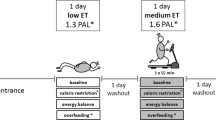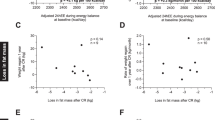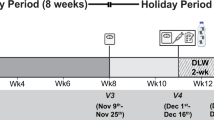Abstract
Objective: Restrained eating is a common dietary practice among individuals who are attempting to prevent weight gain, but little is known about differences in energy physiology and regulation between restrained and unrestrained eaters. We investigated this issue in non-obese free-living postmenopausal women classified as long-term restrained (n=26) or unrestrained (n=34) eaters group matched for body mass index (BMI).
Measurements: Measurements were made of total energy expenditure (TEE), resting energy expenditure (REE), body composition, reported leisure time activity, maximal aerobic capacity (VO2max) and weight change during the study period. In addition, physical activity level (PAL) and nonexercise activity thermogenesis (NEAT) were calculated from measured variables.
Results: There were no significant differences between the groups in body composition, weight change, aerobic capacity or total leisure time activity. Relationships between fat-free mass (FFM) and both REE and TEE, and the relationship between work load and energy expenditure in the test of maximal oxygen consumption, were also not different between groups. However, restrained eaters had a significantly lower PAL (equal to TEE/REE, 1.72±0.04 vs 1.84±0.04, P<0.05). In addition, in multiple regression models predicting NEAT, NEAT was significantly lower in restrained eaters than unrestrained eaters and there was a positive relationship between NEAT and weight change in unrestrained eaters but no relationship in restrained eaters (P<0.05).
Conclusions: In contrast to a previous report, we found no significant difference in TEE between restrained and unrestrained eaters. PAL was slightly lower in restrained eaters, apparently due to reduced NEAT, and restrained eaters also lacked the positive association between NEAT and body weight change seen in unrestrained eaters. This latter finding, if confirmed in future studies, could help explain an increased susceptibility of restrained eaters to weight gain.
Sponsorship: NIH grants AG12829, DK46124 and T32AG00209, and US Cooperative Agreement number 58-1950-9-001.
European Journal of Clinical Nutrition (2001) 55, 1059–1067
This is a preview of subscription content, access via your institution
Access options
Subscribe to this journal
Receive 12 print issues and online access
$259.00 per year
only $21.58 per issue
Buy this article
- Purchase on Springer Link
- Instant access to full article PDF
Prices may be subject to local taxes which are calculated during checkout
Similar content being viewed by others
References
Barr SI, Prior JC & Vigna YM (1994) Restrained eating and ovulatory disturbances: possible implications for bone health Am. J. Clin. Nutr. 59 92–97
Bathalon GP, Hughes VA, Campbell WW, Fiatarone MA & Evans WJ (1995) Military body fat standards and equations applied to middle-aged women Med. Sci. Sports Exerc. 27 1079–1085
Bathalon GP, Tucker KL, Hays NP, Vinken AG, Greenberg AS, MA McCrory & Roberts SB (2000) Psychological measures of eating behavior and the accuracy of 3 common diet methodologies in healthy postmenopausal women Am. J. Clin. Nutr. 71 739–745
Bingham SA, Cassidy A, Cole TJ et al (1995) Validation of weighed records and other methods of dietary assessment using the 24 h urine nitrogen technique and other biological markers Br. J. Nutr. 73 531–550
Black AE, Prentice AM & Coward WA (1986) Use of food quotients to predict respiratory quotient for the doubly-labelled water method of measuring energy expenditure Hum. Nutr. Clin. Nutr. 40C 381–391
Dallal GE & Roberts SB (1991) DLW: a computer program for the calculation of total energy expenditure in doubly labeled water (2H2 18O) studies Comp. Biomed. Res. 24 143–151
de Castro JM (1995) The relationship between cognitive restraint to the spontaneous food and fluid intake of free-living humans Physiol. Behav. 57 287–295
Folsom AR, Jacobs DR Jr, Caspersen CJ, Gomez-Marin O & Knudsen J (1986) Test-retest reliability of the Minnesota Leisure Time Physical Activity Questionnaire J. Chron. Dis. 39 505–511
Hays NP, Bathalon GP, McCrory MA, Roubenoff R, Lipman R & Roberts SB (2001) Eating behavior correlates of adult weight gain and obesity at age 55–65 y in healthy women Am. J. Clin. Nutr. (in press).
Herman CP & Mack D (1975) Restrained and unrestrained eating J. Person. 43 647–660
Klesges RC, Isbell TR & Klesges LM (1992) Relationship between dietary restraint, energy intake, physical activity, and body weight: a prospective analysis J. Abnorm. Psychol. 101 668–674
Laessle RG, Tuschl RJ, Kotthaus BC & Pirke KM (1989) Behavioral and biological correlates of dietary restraint in normal life Appetite 12 83–94
Lawson OJ, Williamson DA, Champagne CM et al (1995) The association of body weight, dietary intake, and energy expenditure with dietary restraint and disinhibition Obes. Res. 3 153–161
Levine JA, Eberhardt NL & Jensen MD (1999) Role of nonexercise activity thermogenesis in resistance to fat gain in humans Science 283 212–214
Lindroos AK, Lissner L, Mathiasen ME et al (1997) Dietary intake in relation to restrained eating, disinhibition, and hunger in obese and nonobese Swedisch women Obes. Res. 5 175–182
Lohman TG, Roche AF & Martorell R (1998) Anthropometric Standardization Reference Manual Champaign, IL: Human Kinetics.
Poehlman ET, Viers HF & Detzer M (1991) Influence of physical activity and dietary restraint on resting energy expenditure in young nonobese females Can. J. Physiol. Pharmac. 69 320–326
Roberts SB, Young VR, Fuss P et al (1990) Energy expenditure and subsequent nutrient intakes in overfed young men Am. J. Physiol. 259 R461–R469
Roberts SB, Young VR, Fuss P et al (1992) What are the dietary energy needs of elderly adults? Int. J. Obes. Relat. Metab. Disord. 16 969–976
Roberts SB, Pi-Sunyer X, Kuller L, Lane M, Ellison P, Prior J & Shapses S (2001) Physiologic effects of lowering caloric intake in non-human primates and non-obese humans J. Gerontol. 564(special issue 1) 66–75
Saltzman E & Roberts SB (1995) The role of energy expenditure in energy regulation: findings from a decade of research Nutr. Rev. 53 209–220
Saltzman E & Roberts SB (1996) Effects of energy imbalance on energy expenditure and respiratory quotient in young and older men: a summary of data from two metabolic studies Aging Clin. Exp. Res. 8 370–378
Schweiger U, Tuschl RJ, Platte P, Broocks A, Laessle RG & Pirke KM (1992) Everyday eating behavior and menstrual function in young women Fertil. Steril. 57 771–775
Siri WE (1961) Body composition from fluid spaces and density: analysis of methods. In: Techniques for Measuring Body Composition, ed. J Brozek, A Hensche 223–244 Washington, DC: National Academy of Sciences
Stunkard AJ & Messick S (1985) The three-factor eating questionnaire to measure dietary restraint, disinhibition and hunger J. Psychosom. Res. 29 71–83
Surrao J, Sawaya AL, Dallal GE, Tsay R & Roberts SB (1998) Use of food quotients in human doubly labeled water studies: comparable results obtained with 4 widely used food intake methods J. Am. Diet. Assoc. 98 1015–1020
Taylor HL, Jacobs DR, Schucker B, Knudsen J, Leon AS & DeBacker GA (1978) Questionnaire for the assessment of leisure time physical activities J. Chron. Dis. 31 741–755
Tuschl RJ, Platte P, Laessle RG, Stichler W & Pirke KM (1990) Energy expenditure and everyday eating behavior in healthy young women Am. J. Clin. Nutr. 52 81–86
Verboeket-van de Venne W, Westerterp KR & ten Hoor F (1994) Substrate utilization in man: effects of dietary fat and carbohydrate Metabolism 43 152–156
Vogel JA, Patton JF, Mello RP & Daniels WL (1986) An analysis of aerobic capacity in a large United States population J. Appl. Physiol. 60 494–500
Weindruch R & Walford RL (1988) The Retardation of Aging and Disease by Dietary Restriction Springfield, IL: CC Thomas
Weir JB de (1949) New methods for calculating metabolic rate with special reference to protein J. Physiol. 109 1–9
Westenhoefer J, Pudel V & Maus N (1990) Some restrictions on dietary restraint Appetite 14 137–141
Wilmore JH (1969) A simplified method for determination of residual lung volumes J. Appl. Physiol. 27 96–100
World Health Organization (1985) Energy and protein requirements. Report of a joint FAO/WHO/UNU expert consultation. Technical report series 724. Geneva: World Health Organization
Acknowledgements
We gratefully thank the volunteers who participated in the study. We also acknowledge the expert assistance given by the recruiting department and the nursing staff of the Metabolic Research Unit for their professional assistance in data collection and care of the volunteers.
Author information
Authors and Affiliations
Corresponding author
Rights and permissions
About this article
Cite this article
Bathalon, G., Hays, N., McCrory, M. et al. The energy expenditure of postmenopausal women classified as restrained or unrestrained eaters. Eur J Clin Nutr 55, 1059–1067 (2001). https://doi.org/10.1038/sj.ejcn.1601268
Received:
Revised:
Accepted:
Published:
Issue Date:
DOI: https://doi.org/10.1038/sj.ejcn.1601268
Keywords
This article is cited by
-
Restrained Eating Behavior and the Metabolic Response to Dietary Energy Restriction in Women
Obesity Research (2004)
-
Metabolic aging and predicted longevity: Results of a cross-sectional study in post-menopausal women
Aging Clinical and Experimental Research (2002)



